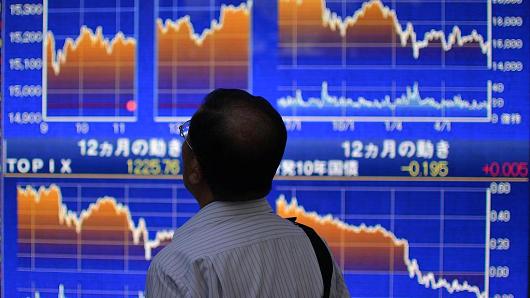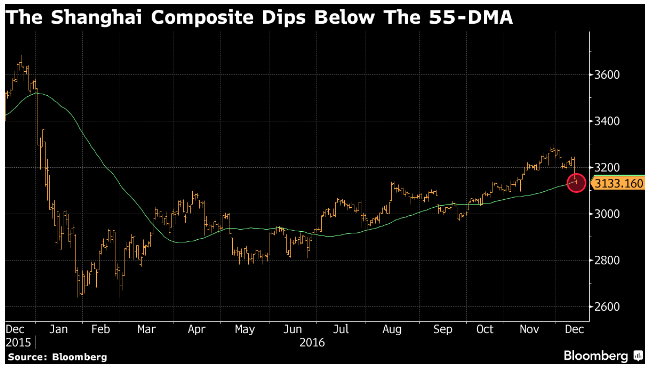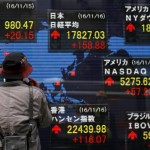Shanghai stocks extended their worst losses in six months and the dollar’s rally faltered

-
U.S. oil hovers below $53 a barrel after OPEC-fueled advance
-
Shanghai share index declines as sovereign yield keeps rising
Shanghai stocks extended their worst losses in six months and the dollar’s rally faltered as investors weigh the impact of monetary tightening in the world’s two largest economies. Bonds consolidated following a two-month collapse.
Shares in Shanghai slipped even as China’s official data showed stronger-than-expected industrial output and retail sales, while yuan government bonds extended losses. Sovereign debt in most other markets snapped declines as oil failed to build on a rally spurred by OPEC’s deal with rivals to curb production. The yen held its advance versus the dollar, while the Korean won and Indonesian rupiah gained.

Investors are focused on the impact of People’s Bank of China monetary tightening and this week’s Federal Reserve meeting, with inflationary pressures coming to the fore of global central-bank thinking. The market sees 100 percent odds of a rate hike in the U.S. Wednesday, and a two-in-three chance of additional tightening by June. Chinese regulators are pushing money market rates higher and curbing leveraged purchases of both stocks and bonds, just as U.S. President-elect Donald Trump’s throws relations with China into disarray.
“The figures are good but the market sentiment remains cautious after a big drop yesterday,” said Linus Yip, a Hong Kong-based strategist at First Shanghai Securities Ltd. “For the past two months people were quite excited that insurers’ money was helping to push up the market but they did it too drastically.”
Stocks
- The Shanghai Composite Index slid 0.7 percent as of 12:40 p.m. local time, after dropping 2.5 percent on Monday, while Hong Kong’s Hang Seng index lost 0.4 percent. Industrial production rose 6.2 percent in November from a year earlier, while retail sales surged 10.8 percent, giving policy makers room to switch focus from stimulus to curbing financial risks.
- Almost 60 more stocks fell than rose on the dollar-denominated MSCI Asia Pacific Index, which was little changed. Japan’s Topix Index swang between gains and losses, the Jakarta Composite index lost 0.5 percent and the Philippine benchmark dropped 1 percent.
- Australia’s S&P/ASX 200 Index slid 0.3 percent, while New Zealand’s S&P/NZX 50 Index slipped 0.4 percent.
- S&P 500 Index futures were little changed following a 0.1 percent decline in the underlying benchmark last session that knocked it from a record high.
Currencies
- The yen weakened by 0.1 percent to 115.13 per dollar, following Monday’s 0.3 percent climb.
- The won added 0.1 percent versus the dollar amid President Park Geun-hye’s impeachment, while the rupiah and the peso added 0.2 percent.
- The Bloomberg Dollar Spot Index, a gauge of the greenback against 10 major peers, steadied after sinking 0.6 percent last session, its steepest drop since September.
- “With a rate hike at this week’s FOMC fully priced and given the strong rally in the dollar, we are likely seeing some paring of positions,” said Khoon Goh, head of regional research at Australia & New Zealand Banking Group Ltd. in Singapore. “Market participants are also reassessing whether the Trump rally has gotten a bit ahead of itself.”
Bonds
- Australian 10-year bonds led gains in the Asia-Pacific, with yields falling three basis points to 2.82 percent.
- Japanese notes maturing in a decade yielded 0.075 percent, unchanged, as Nomura International Plc said investors are watching the Bank of Japan’s response to the decline in bonds.
- Yields on Treasury notes due in 10 years fell one basis point to 2.47 percent. Rates ended Monday little changed after rising by as much as six basis points to touch 2.53 percent, their highest level since September 2014.
- The yield on China’s three-year sovereign bond climbed four basis points to 2.85 percent.
Commodities
- West Texas Intermediate crude fell 0.3 percent to $52.67 a barrel, after soaring more than 5 percent on Monday.
- U.S. shale output could top 4.542 million barrels a day, a modest increase from December forecasts, the country’s Energy Information Administration said Monday.
- The U.S. forecast comes after the Organization of Petroleum Exporting Countries agreed to cut output by 1.2 million barrels a day starting in January, and other countries led by Russia agreed to trim production by 558,000 barrels a day.
- Copper futures lost 0.6 percent, while zinc declined 0.5 percent.
Source: Bloomberg – China Stocks Drop as Dollar Stalls on Fed Countdown, PBOC Watch
Related Posts
 Asian Stocks, Dollar Steady as Fed Day Arrives; Crude Retreats
Asian Stocks, Dollar Steady as Fed Day Arrives; Crude Retreats Asian Stocks Decline as Iron Ore Futures Tumble: Markets Wrap
Asian Stocks Decline as Iron Ore Futures Tumble: Markets Wrap Asian Shares Joined A Global Rally; Currencies Review
Asian Shares Joined A Global Rally; Currencies Review The dollar inched higher on Wednesday; The euro held steady against the dollar
The dollar inched higher on Wednesday; The euro held steady against the dollar Asia shares rise; the Dow and S&P 500 hit record highs
Asia shares rise; the Dow and S&P 500 hit record highs























